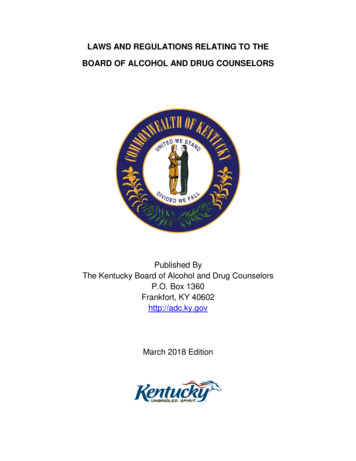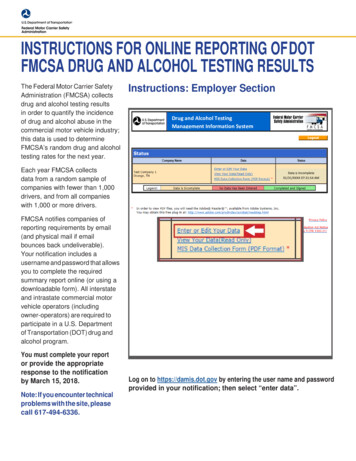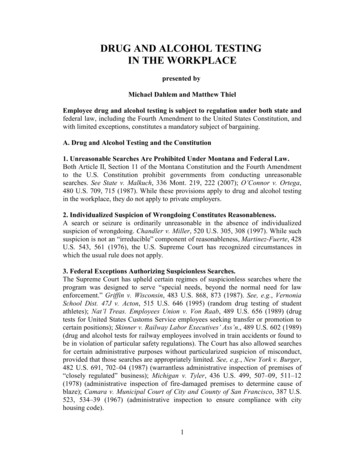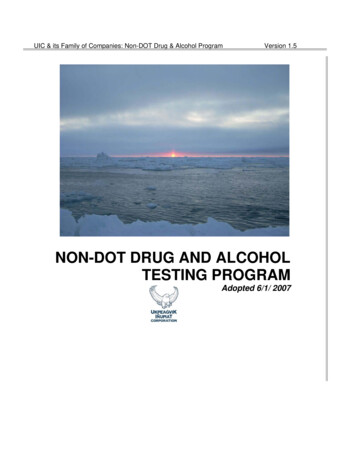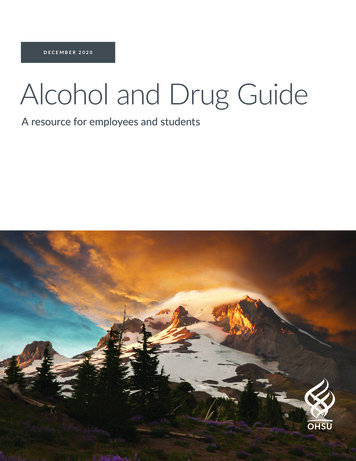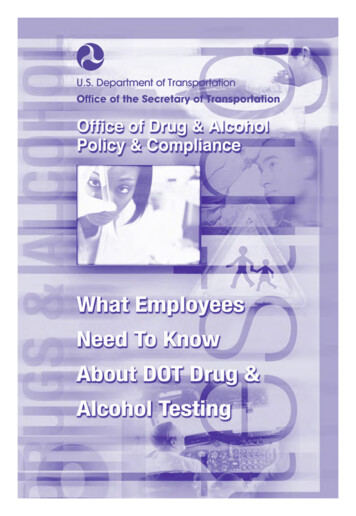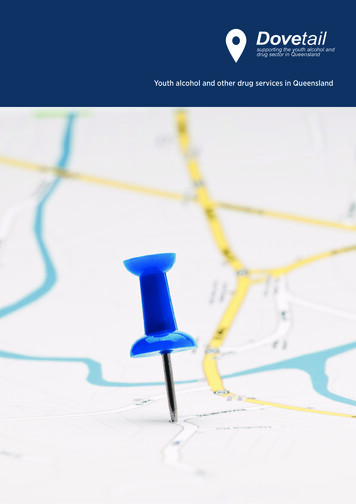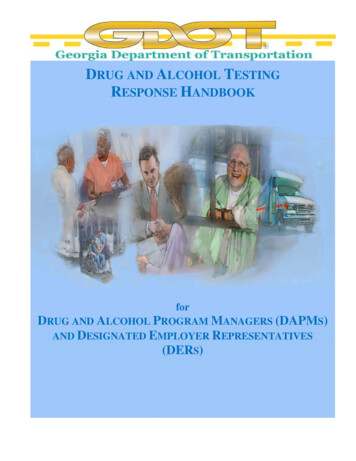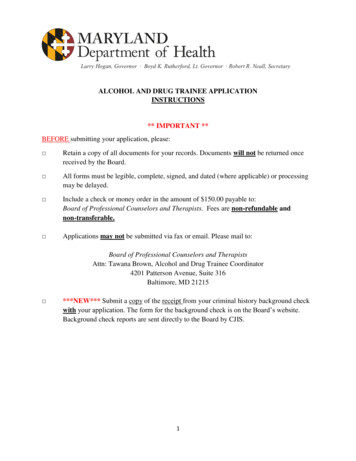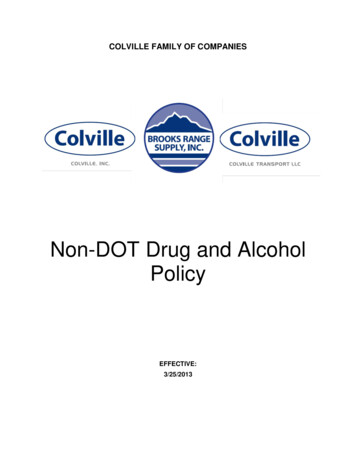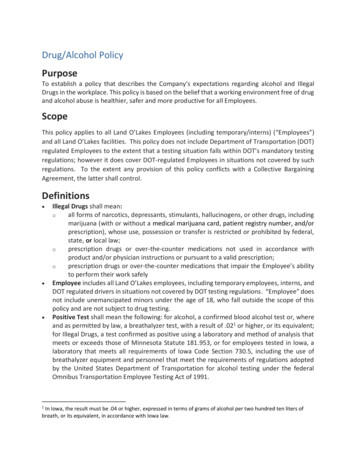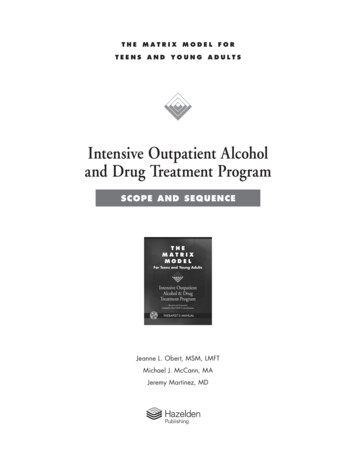
Transcription
THE MATRIX MODEL FORTEENS AND YOUNG ADULTSIntensive Outpatient Alcoholand Drug Treatment ProgramSCOPE AND SEQUENCEJeanne L. Obert, MSM, LMFTMichael J. McCann, MAJeremy Martinez, MD
CONTENTSIntroduction to The Matrix Model for Teens and Young Adults . . . . . . . . . . . . . . . . . . . . . . . . . . . . . . . . . . . . . . . . . . . . . 3What Evidence-Based Approach Is Used? . . . . . . . . . . . . . . . . . . . . . . . . . . . . . . . . . . . . . . . . . . . . . . . . . . . . . . . . . . . . . . . 3What Studies Support the Use of This Program with Adolescents and Young Adults? . . . . . . . . . . . . . . . . . . . . . . . 3What Is New in This Updated Edition of The Matrix Model for Teens and Young Adults? . . . . . . . . . . . . . . . . . . . . . 6What Topics Are Covered? . . . . . . . . . . . . . . . . . . . . . . . . . . . . . . . . . . . . . . . . . . . . . . . . . . . . . . . . . . . . . . . . . . . . . . . . . . . . . 7Implementation of the Matrix Model . . . . . . . . . . . . . . . . . . . . . . . . . . . . . . . . . . . . . . . . . . . . . . . . . . . . . . . . . . . . . . . . . . . . 11Is Training Necessary to Implement The Matrix Model for Teens and Young Adults? . . . . . . . . . . . . . . . . . . . . . . . . 11How Do We Manage Training Staff Turnover? . . . . . . . . . . . . . . . . . . . . . . . . . . . . . . . . . . . . . . . . . . . . . . . . . . . . . . . . . . 11Can Our Program Be Recognized as a Matrix Clinic? . . . . . . . . . . . . . . . . . . . . . . . . . . . . . . . . . . . . . . . . . . . . . . . . . . . . . 12Why Should We Purchase and Use The Matrix Model for Teens and Young Adults? . . . . . . . . . . . . . . . . . . . . . . . . 12About the Authors . . . . . . . . . . . . . . . . . . . . . . . . . . . . . . . . . . . . . . . . . . . . . . . . . . . . . . . . . . . . . . . . . . . . . . . . . . . . . . . . . . . . 14References . . . . . . . . . . . . . . . . . . . . . . . . . . . . . . . . . . . . . . . . . . . . . . . . . . . . . . . . . . . . . . . . . . . . . . . . . . . . . . . . . . . . . . . . . . . 15For more information about this program,visit hazelden.org/bookstore or call 800-328-9000.Copyrighted material. All rights reserved.2 / 16
INTENSIVE OUTPATIENT ALCOHOL AND DRUG TREATMENT PROGRAM THERAPIST’S MANUALIntroduction to The Matrix Model for Teens and Young AdultsThe Matrix Model for Teens and Young Adults, like The Matrix Model for adults, is acomprehensive, organized set of evidence-based therapeutic interventions. It consists ofresearch-based techniques integrated into an approach that includes individual sessions,family sessions, group sessions, Twelve Step programs, and separate parent and youtheducation groups. The complex social environment of the adolescent — including family,school, community, peers, and possibly juvenile justice involvement — is an importantconsideration in developing appropriate treatment, as is the developmental stage of theadolescent. We recognize that many patients entering treatment during their teen oryoung adult years need programming that falls toward the middle of the preventiontreatment continuum. The material in this program was selected, organized, anddesigned to be delivered while taking all of these issues into account. The structureof the program is flexible enough to be adapted to young people who need early-stageintervening, who are experimenting with drugs, or who have already developed asubstance use disorder. It can be used with patients whose families may or may not bewilling and able to participate.What Evidence-Based Approach Is Used?A number of evidence-based practices are integrated into the The Matrix Model forTeens and Young Adults. They include cognitive-behavioral therapy (CBT), motivationalinterviewing (MI), Twelve Step facilitation (TSF), and contingency management (CM).What Studies Support the Use of This Programwith Adolescents and Young Adults?Teen Addiction Severity Index (Teen-ASI) research was conducted with The MatrixModel for Teens and Young Adults. The T-ASI assesses seven domains: chemical (alcohol and other drug) use school status employment-support status family relationships peer/social relationships legal status psychiatric statusFor more information about this program,visit hazelden.org/bookstore or call 800-328-9000.Copyrighted material. All rights reserved.3 / 16
INTENSIVE OUTPATIENT ALCOHOL AND DRUG TREATMENT PROGRAM THERAPIST’S MANUALThe T-ASI was administered at intake, three months after intake, and again six monthsafter intake. The research reports that adolescent patients in The Matrix Model for Teensand Young Adults program showed significant improvements on the T-ASI severityscales at the six-month follow-up in all domains (chemical use, school, family, peer/social,legal, psychiatric) except work. The patients showed significant decreases in alcohol andother drug use at the six-month follow-up compared to intake. A full 52 percent of theadolescent Matrix Model patients reported no drug use at the six-month assessment.This is compared to only 24 percent of adolescent patients from the Cannabis YouthTreatment comparison study.Cognitive-Behavioral TherapyCognitive-behavioral therapy (CBT) is used as patients are taught to analyze eventsand to change thoughts and behaviors that precede substance use, which can resultin a different outcome. Patients are also taught skills for stopping alcohol and druguse and preventing relapse, guided in identifying and planning events that are notassociated with substance use, and rewarded for using the tools and accomplishing theassignments. Other aspects of CBT include the development of alternative behaviors thatare unlikely to result in alcohol or other drug use, in other words, a change in lifestyle.Regular urine testing is also a part of this approach. These essential aspects of CBTare also outlined in the cognitive-behavioral approach manual written by Kadden et al.(1992). This relapse prevention work has its roots in the work of Marlatt and Gordon(1985), and research has shown it to be effective in treating different types of substanceuse disorders (Carroll et al. 1994; Carroll and Onken 2005; Rawson et al. 2004).Motivational InterviewingAdolescents and young adults often ambivalent about discontinuing their use ofsubstances. From a developmental perspective, teens are moving through a transitionalstage in their lives during which risk-taking is normal, disengagement from parents isnecessary, and connecting with peers becomes the goal. Drinking and experimentingwith drugs (especially marijuana) are common.The Matrix Model for Teens and Young Adults contains an initial session for thepatient and the family that uses motivational interviewing to increase the likelihoodof their parents’ and caregivers’ continued participation in treatment, therebyexposing them to new ways of thinking about drugs and teens, as well as improvingtheir parenting skills. Using MI is intended to help the adolescent resolve his or herambivalence regarding treatment attendance and the use of mind-altering substances,For more information about this program,visit hazelden.org/bookstore or call 800-328-9000.Copyrighted material. All rights reserved.4 / 16
INTENSIVE OUTPATIENT ALCOHOL AND DRUG TREATMENT PROGRAM THERAPIST’S MANUALat least during the treatment episode. Attempting this period of abstinence gives theadolescent more information about discontinuing substance use, avoiding substanceuse disorder, and the degree of difficulty he or she might have with these issues. Thisapproach has been supported by research (Copeland et al. 2001; Stephens et al. 2000;Martin et al. 2005) and has been integrated with CBT into interventions (Sampl andKadden 2001).Twelve Step FacilitationMultiple outcome studies have shown that people who use a Twelve Step program inaddition to the cognitive-behavioral interventions that are part of the Matrix Model dobetter in long-term recovery (Brecht et al. 2000). The Matrix Model for Teens and YoungAdults emphasizes the critical importance of many of TSF’s principles and encouragespatients to use Twelve Step programs in the initial intensive phase of treatment forseveral reasons. A spiritual component is an important element of the Matrix Model’sbiopsychosocial approach to recovery. In the United States, Twelve Step programs arean easy and safe way to find peers or other people who are doing recovery-orientedactivities. These groups also provide ongoing social support and sponsorship for therecovery process after the intensive phase of the Matrix program ends. Althoughpatients are not denied access to treatment if they are opposed to going to thesemeetings, everyone should acquire familiarity with Twelve Step programs. Programsusing the Matrix Model are encouraged to conduct Twelve Step meetings on-site to makeattendance more attractive to program participants. It is important to inform all teensand young adults entering treatment that the most successful patients place substantialreliance on Twelve Step programs for emotional support and nurturing.Contingency ManagementThe Matrix Model for Teens and Young Adults includes many different uses of contingencymanagement that are simple and inexpensive, including social reinforcement and rewardssuch as stickers, pizza parties, and gift cards. A large amount of research supports theefficacy of the systematic use of reinforcement for meeting specific behavioral criteriain the treatment of substance use disorders (Higgins et al. 1994, 2000; Iguchi et al.1997; Petry et al. 2000; Rawson et al. 2002, 2006), which has been successful when usedwith adolescents (Branson et al. 2012; Stewart et al. 2015; Morean et al. 2015; Stanger,et al. 2015). Contingency management research with substance use disorders usuallyhas specified drug-free urine results, attendance at treatment sessions, or achievingtreatment goals as the basis for receiving incentives. Participants in research studiesFor more information about this program,visit hazelden.org/bookstore or call 800-328-9000.Copyrighted material. All rights reserved.5 / 16
INTENSIVE OUTPATIENT ALCOHOL AND DRUG TREATMENT PROGRAM THERAPIST’S MANUALusually receive certificates that are redeemable for items with monetary value rangingfrom as little as one dollar to as much as several hundred dollars. Coupled with socialrecognition, relatively inexpensive items can have a strong effect on behavior (Bransonet al. 2012). This approach has long been a part of both the educational system andparenting-skills training. Contingency management has not made significant inroadsinto treatment, but this powerful tool is extremely useful and effective in adolescenttreatment services.What Is New in This Updated Edition ofThe Matrix Model for Teens and Young Adults?Several new changes to the manual cover the latest addiction treatment standards. Eachsession of The Matrix Model for Teens and Young Adults has been reviewed and updatedfor accuracy and to ensure ASAM compliance for terms and definitions. The entiremanual and all group sessions were reviewed to add the latest information about specificdrugs and their impact on the brain and body. This updated program includes severalnew components.Meets ASAM Criteria for Young AdultsThe program has been updated to meet the adult ASAM Criteria for IntensiveOutpatient Treatment (Level 2.1) of young adults 18 years or older. This is accomplishedby providing an expanded format of the Early Recovery Group designating a time forSite-Specific groups, both of which assure a full three-hour day, as required by ASAMcriteria for adults (those 18 or older). This new component is the Early Recovery YoungAdult Group.Serves Clients Using Medication-Assisted TreatmentThe Matrix Model has also been upgraded to include a version of the Individualand Family Sessions specifically for use with patients who are considering or usingmedication-assisted treatment. This new component is Individual and Family Sessionswith MAT (Medication-Assisted Treatment). The Family Program session topics havebeen updated to include the latest information about the use of prescription medications,synthetic cannabinoids, e-cigarettes, and other addictive substances.The Family Program also recommends the use of three new videos that offer up-todate information on all the common addictive substances and how recovery works foryoung patients and their families.For more information about this program,visit hazelden.org/bookstore or call 800-328-9000.Copyrighted material. All rights reserved.6 / 16
INTENSIVE OUTPATIENT ALCOHOL AND DRUG TREATMENT PROGRAM THERAPIST’S MANUALUpdated Video SelectionsThe revised Family Program is now matched with three new Hazelden videos (soldseparately at a discount when you purchase the program).1. Young Adults Discover the 12 Steps2. Youth and Drugs of Abuse3. Medical Aspects of Substance Use DisorderThese three videos can be used to deepen the learning by matching the topics in theFamily Group sessions.What Topics Are Covered?The Matrix Model for Teens and Young Adults program includes instruction on howto deliver seven different treatment groups:1. Individual and Family Sessions2. Individual and Family Sessions with MAT (Medication-Assisted Treatment)3. Early Recovery Adolescent Group (for clients 13 through 17 years of age)4. Early Recovery Young Adult Group (for clients 18 through 25 years of age)5. Relapse Prevention Group6. Family Program: Parent Education Group7. Family Program: Youth Education GroupThe following lists show the sessions and topics for each group.Individual and Family Sessions (8 sessions)Session 1: Orientation (Individual and Family)Session 2: Establishing Boundaries (Family)Session 3: Be Prepared (Individual)Session 4: Learning to Communicate (Family)Session 5: Resolving Conflicts (Family)Session 6: Goals: Where Do You Want to Be? (Individual)Session 7: Sharing Goals with Family (Family)Session 8: Managing Relapse (Optional Session for Family or Individual)For more information about this program,visit hazelden.org/bookstore or call 800-328-9000.Copyrighted material. All rights reserved.7 / 16
INTENSIVE OUTPATIENT ALCOHOL AND DRUG TREATMENT PROGRAM THERAPIST’S MANUALIndividual and Family Sessions with MAT (Medication-Assisted Treatment)(9 sessions)Session 1: Orientation (Individual and Family)Session 2: Orientation to Medications (Individual and Family)Session 3: Establishing Boundaries (Family)Session 4: Be Prepared (Individual)Session 5: Learning to Communicate (Family)Session 6: Resolving Conflicts (Family)Session 7: Goals: Where Do You Want to Be? (Individual)Session 8: Sharing Goals with Family (Family)Session 9: Managing Relapse (Optional Session for Family or Individual)Early Recovery Adolescent Group (8 sessions)Session 1: Admitting You Have a ProblemSession 2: Stop the Trigger CycleSession 3: Thought-StoppingSession 4: Identifying External TriggersSession 5: Identifying Internal TriggersSession 6: Readiness for ChangeSession 7: Early Recovery ChallengesSession 8: Healing Your Body and BrainEarly Recovery Skills Young Adult Group (16 sessions)Session 1: Admitting You Have a ProblemSession 2: Assessing Recovery ProgressSession 3: Stop the Trigger CycleSession 4: Adopting a Healthy LifestyleSession 5: Thought-StoppingSession 6: Thoughts, Emotions, and BehaviorSession 7: Identifying External TriggersSession 8: Dealing with RelapseSession 9: Identifying Internal TriggersSession 10: Reassessing Recovery ProgressSession 11: Readiness for ChangeSession 12: Be Smart, Not StrongFor more information about this program,visit hazelden.org/bookstore or call 800-328-9000.Copyrighted material. All rights reserved.8 / 16
INTENSIVE OUTPATIENT ALCOHOL AND DRUG TREATMENT PROGRAM THERAPIST’S MANUALSession 13: Alcohol ArgumentsSession 14: Addictive BehaviorSession 15: Healing Your Body and BrainSession 16: Early Recovery ChallengesRelapse Prevention Group (32 sessions)Session 1: The Past and the PresentSession 2: Relapse Justification ISession 3: Dealing with ProblemsSession 4: A Matter of Life and DeathSession 5: Users in My HomeSession 6: Having a Good Time without Being HighSession 7: Clean and SoberSession 8: Destructive BehaviorsSession 9: School and Future GoalsSession 10: Prescription Medications and OpioidsSession 11: Twelve Step TipsSession 12: TrustSession 13: Relapse Is a Setback, Not a FailureSession 14: Managing AngerSession 15: TruthfulnessSession 16: I’m Not Cool If I Don’t UseSession 17: Dealing with Feelings and DepressionSession 18: Staying BusySession 19: Guilt and ShameSession 20: Taking Care of YourselfSession 21: Life Satisfaction ScaleSession 22: Relapse Justification IISession 23: Motivation for RecoverySession 24: What Would You Do If ?Session 25: Sex and RecoverySession 26: Repairing RelationshipsSession 27: One Day at a TimeSession 28: Today I Feel Session 29: Twelve Step IntroductionFor more information about this program,visit hazelden.org/bookstore or call 800-328-9000.Copyrighted material. All rights reserved.9 / 16
INTENSIVE OUTPATIENT ALCOHOL AND DRUG TREATMENT PROGRAM THERAPIST’S MANUALSession 30: Making New FriendsSession 31: Avoiding Relapse DriftSession 32: Up in SmokeGraduation (optional)Family Program: Parent Education Group (12 sessions)Session 1: Road Map for Recovery (Video)Session 2: How Well Is Our Family Functioning? (Discussion)Session 3: Medical Aspects of Addiction (Video)Session 4: Parents Sharing Experiences (Panel)Session 5: Developmental Issues for Teens (Discussion)Session 6: Triggers and Cravings (Video)Session 7: What about Relapse? (Discussion)Session 8: Recovering Teens Share Experiences (Panel)Session 9: Families in Recovery (Video)Session 10: Family Conflict: Is It Okay? (Discussion)Session 11: Introduction to the Twelve Steps (Video)Session 12: Who’s in Charge Here Anyway? (Discussion)Family Program: Youth Education Group (12 sessions)Session 1: Road Map for Recovery (Video)Session 2: Addiction as a Disease (Video)Session 3: Choosing Not to Use (Video)Session 4: Taking Care of Your Body and Brain (Video)Session 5: Triggers and Cravings (Video)Session 6: Alcohol and Other Sedatives (Video)Session 7: Tobacco and E-cigarettes (Video)Session 8: Marijuana and Synthetic Cannabinoids (Video)Session 9: Opioids and Prescription Painkillers (Video)Session 10: Families in Recovery (Video)Session 11: Introduction to the Twelve Steps (Video)Session 12: Giving Back: Matrix Graduate Panel (Discussion)For more information about this program,visit hazelden.org/bookstore or call 800-328-9000.Copyrighted material. All rights reserved.10 / 16
INTENSIVE OUTPATIENT ALCOHOL AND DRUG TREATMENT PROGRAM THERAPIST’S MANUALImplementation of the Matrix ModelThe Matrix Model for Teens and Young Adults covers a wide age range, from adolescents(those 13 through 17 years of age) to young adults (those 18 through 25 years). The modelis implemented differently, depending on the age of the patients. The Early RecoveryAdolescent Group is designed for patients younger than age 18, and should be used for thatpopulation. This group meets ASAM Level 2.1 Criteria for adolescents (minimum of 6hours per week). The Early Recovery Young Adult Group meets the adult ASAM Level2.1 Criteria of 9 hours per week for patients 18 years and older. To meet the adult ASAMCriteria Level 2.1, additional Site-Specific groups have also been added to the schedule.New for this edition of The Matrix Model for Teens and Young Adults is the additionof a version of the Individual and Family Sessions for patients using medication-assistedtreatment (MAT). For patients not using MAT, the traditional Individual and FamilySessions may be used.Is Training Necessary to ImplementThe Matrix Model for Teens and Young Adults?Although training is not necessary to implement the Matrix Model, programs that aremost successful in implementing the model to fidelity are those whose staff membershave received training. Live training provides the ability to ask questions aboutimplementation and avoid common pitfalls of beginning a new treatment model. Thetwo-day Matrix Model Basic Core Training is a provided by the Matrix Institute duringa open-enrollment training in Los Angeles, California, or by arranging for a session atyour site.How Do We Manage Training Staff Turnover?A common problem arises when staff are trained, but then leave for other employmentopportunities. This can be managed by identifying a Key Supervisor at your site whois trained on the fidelity standards of the Matrix Model. The Key Supervisor acts as aninternal trainer for your organization, to train new therapists in the Matrix Model. TheKey Supervisor should be person who has extensive experience using the model and iscommitted to staying with your organization. Key Supervisor Training is a one and ahalf days of live training provided by the Matrix Institute.For more information about this program,visit hazelden.org/bookstore or call 800-328-9000.Copyrighted material. All rights reserved.11 / 16
INTENSIVE OUTPATIENT ALCOHOL AND DRUG TREATMENT PROGRAM THERAPIST’S MANUALCan Our Program Be Recognized as a Matrix Clinic?The Matrix Model is a trademarked product and service package, so a facility maynot claim to be a Matrix Clinic. However, your facility may be recognized as a MatrixCertified Site. Matrix Certification requires a facility to be using the Matrix Model forat least six months with a Key Supervisor in place. The Matrix Institute will provide asite visit and review recorded Matrix Model sessions to grant either a two- or three-yearcertification. To assure fidelity of these practices, individual programs may be certifiedin the Matrix Model.To learn more about training or certification,please visit matrixinstitute.org or call 877-422-2353.Why Should We Purchase and UseThe Matrix Model for Teens and Young Adults?The Matrix Model for Teens and Young Adults is adapted from the evidence-basedadult program. The teen and young adult version is a comprehensive, organized set ofevidence-based therapeutic interventions. This includes cognitive-behavioral therapy(CBT), motivational interviewing (MI), Twelve Step facilitation (TSF), and contingencymanagement (CM). Although there has not been a controlled trial of the Matrixadolescent treatment, much support exists for the best-practice therapy elements thatcomprise the program (CBT, MI, TSF, and CM).The Matrix Adolescent Treatment Model is recognized in Treating Teens: A Guideto Adolescent Drug Programs, published by Drug Strategies (2003), as an exemplarytreatment approach. The Matrix Model was tested in the CSAT-sponsoredMethamphetamine Treatment Project (Rawson et al. 2004), the largest randomizedclinical trial of treatments for methamphetamine use disorders to date. The studyreported that in the overall sample, and in the majority of sites, those who wereassigned to Matrix Model treatment succeeded in the following: The patients attended more clinical sessions. They stayed in treatment longer. They provided more methamphetamine-free urine samples during the treatmentperiod. They had longer periods of methamphetamine abstinence than those assigned toreceive treatment as usual.For more information about this program,visit hazelden.org/bookstore or call 800-328-9000.Copyrighted material. All rights reserved.12 / 16
INTENSIVE OUTPATIENT ALCOHOL AND DRUG TREATMENT PROGRAM THERAPIST’S MANUALThe Matrix Model has been recognized by the U.S. Federal Government duringtestimony before the U.S. Senate Appropriations Committee during its hearing onmethamphetamine use disorders (U.S. Senate, 2005). In addition, the National Instituteon Drug Abuse (NIDA) has recognized the Matrix Model as one of only eight evidencebased practices for addiction treatment (NIDA, 2012).In addition, Teen ASI outcome data were presented at the Joint Meeting onAdolescent Treatment Effectiveness, JMATE, in Washington, D.C. (2008). There was asignificant reduction in self-reported days of drug use from intake to six-month follow-up(11.9 days compared to 3.9 days), and two-thirds reported no alcohol or other drug use.Teen ASI severity scores for the Matrix adolescents reflected significant improvementin seven of eight areas, with work being the one exception. At six-month follow-up,52 percent of the adolescents using The Matrix Model for Teens and Young Adultsreported no drug or alcohol use, compared to 24 percent of those in the Cannabis YouthTreatment Project (Dennis 2000).”For more information about this program,visit hazelden.org/bookstore or call 800-328-9000.Copyrighted material. All rights reserved.13 / 16
INTENSIVE OUTPATIENT ALCOHOL AND DRUG TREATMENT PROGRAM THERAPIST’S MANUALAbout the AuthorsThe authors of the Matrix Model for Teens and Young Adults are clinicians and researcherswho have worked extensively with people who have substance use and mental health issues.Jeanne L. Obert, MSM, LMFT, is a co-founder and president of the Matrix Institute Boardof Directors. Ms. Obert is a licensed marriage and family therapist and supervisor, amotivational interviewing trainer trained by Bill Miller, and a consultant for the NationalInstitute on Drug Abuse (NIDA) and the Center for Substance Abuse Treatment (CSAT).She served as an expert trainer on a motivational enhancement study led by Yale Universityas part of the NIDA Clinical Trials Network (CTN) and has created a system designedto disseminate the Matrix Model nationally and internationally. Obert has authored orcoauthored more than fifty articles, book chapters, and treatment manuals, including theadult Matrix Model and related publications.Michael J. McCann, MA, is one of the founders of the Matrix Institute and creators ofthe Matrix Model. He has more than thirty years of experience in substance use disordertreatment and research and he has authored or coauthored more than forty articles andbooks in the area. He has been the principal investigator for NIDA- and CSAT-fundedprojects evaluating pharmacologic and behavioral treatments for methamphetamine usedisorder. He also has been the project director for CSAT-funded grants that expand treatmentservices for opioid use disorders and provide evidence-based enhancements to standardservices. McCann has developed and overseen the operation of Matrix clinics, as well as theintegration of many research projects within these sites. He has trained and lectured onevidence-based behavioral interventions, pharmacologic treatments, methamphetamine usedisorder, and the implementation of research findings into clinical practice.Jeremy Martinez, MD, is a board-certified addiction psychiatrist and the CEO of the MatrixInstitute on Addictions. Dr. Martinez also serves as a clinical instructor at the UCLA Schoolof Medicine. He has authored numerous book chapters and articles and has given lecturesinternationally on the topics of psychosocial addiction treatment, medication-assistedtreatment, and cultural psychiatry. His focus at Matrix has been to enhance the scope ofmedication-assisted treatment, develop programming for co-occurring disorders, furtherdevelop its training department, expand research activities, and assure that Matrix continuesthe high-quality treatment for which it is known.For more information about this program,visit hazelden.org/bookstore or call 800-328-9000.Copyrighted material. All rights reserved.14 / 16
INTENSIVE OUTPATIENT ALCOHOL AND DRUG TREATMENT PROGRAM THERAPIST’S MANUALReferencesBranson, C. E., A. M. Barbuti, P. Clemmey, L. Herman,and P. Bhutia,. 2012. “A Pilot Study ofLow-Cost Contingency Management to Increase Attendance in an Adolescent Substance AbuseProgram.” American Journal on Addictions 21 (2): 126–129. doi:10.1111/j.1521-0391.2011.00204.x.Brecht, M. L., C. von Mayrhauser, and M. D. Anglin. (2000). “Predictors of Relapse AfterTreatment for Methamphetamine Use.” Journal of Psychoactive Drugs 32 (2): ll, K. M., and L. S. Onken. 2005. “Behavioral Therapies for Drug Abuse.” American Journalof Psychiatry 162 (8): 1452–60.Carroll, K. M., B. J. Rounsaville, C. Nich, L. T. Gordon, P. W. Wirtz, and F. Gawin. 1994. “One-YearFollow-Up of Psychotherapy and Pharmacotherapy for Cocaine Dependence: Delayed Emergenceof Psychotherapy Effects.” Archives of General Psychiatry 51 (12): 989–97.Copeland, J., W. Swift, R. Roffman, and R. Stephens. 2001. “A Randomized Controlled Trial ofBrief Cognitive-Behavioral Interventions for Cannabis Use Disorder.” Journal of SubstanceAbuse Treatment 21 (2): 55–64.Higgins, S. T., A. J. Budney, W. K. Bickel, F. E. Foerg, R. Donham, and G. J. Badger. 1994.“Incentives Improve Outcome in Outpatient Behavioral Treatment of Cocaine Dependence.”Archives of General Psychiatry 51 (7): 568–76.Higgins, S. T., C. J. Wong, G. J. Badger, D. E. H. Ogden, and R. L. Dantona. 2000. “ContingentReinforcement Increases Cocaine Abstinence During Outpatient Treatment and 1 Year ofFollow-Up.” Journal of Consulting and Clinical Psychology 68 (1): 64–72.Iguchi, M. Y., M. A. Belding, A. R. Morral, R. J. Lamb, and S. D. Husband. 1997. “ReinforcingOperants Other Than Abstinence in Drug Abuse Treatment: An Effective Alternative forReducing Drug Use.” Journal of Consulting and Clinical Psychology 65 (3): 421–28.Kadden, R., K. M. Carroll, D. Donovan, N. Cooney, P
3 / 16 A or more information about this program visit hazeldenorgboostore or call --orighted aterial All rights resered Introduction to The Matrix Model for Teens and Young Adults The Matrix Model for Teens and Young Adults, like The Matrix Model for adults, is a comprehensive, organized set of evidence-based therapeutic interventions.
